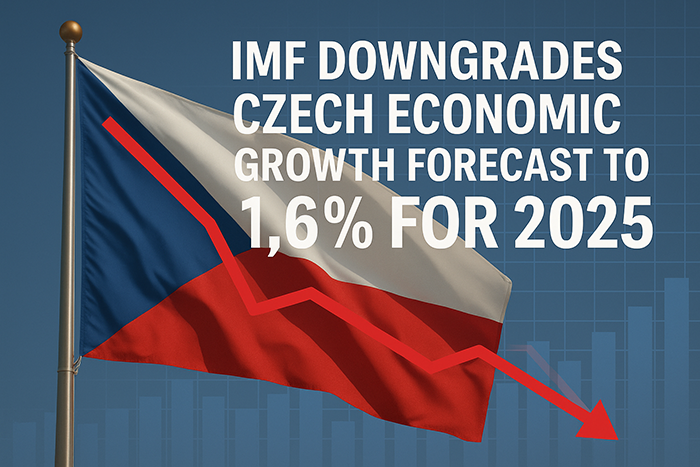IMF downgrades Czech economic growth forecast to 1.6% for 2025
The International Monetary Fund (IMF) has revised its forecast for the Czech Republic’s economic growth, now expecting GDP to increase by 1.6% in 2025. This marks a notable downgrade from its previous projection of 2.4% made in November. The 2024 growth estimate stood at 1.1%. For 2026, the IMF anticipates a slightly higher growth rate of 1.8%.
The downgrade follows broader concerns about international trade tensions and the potential effects of U.S. tariffs. The Czech Ministry of Finance also reduced its growth forecast to 2%, citing the impact of 10% U.S. tariffs on key exports like cars, steel, and aluminum. A further 20% tariff, if implemented, could push Czech growth down to 1.6%, according to the ministry.
Within the Visegrad Group, the Czech Republic is projected to outpace Hungary and Slovakia in 2025, whose economies are expected to grow by 1.4% and 1.3%, respectively. However, Poland is forecast to grow more rapidly at 3.2%. For 2026, Hungary is set to surpass the Czech Republic with 2.6% growth, while Poland’s economy is expected to expand by 3.1%.
The IMF also expects inflation in the Czech Republic to rise slightly to 2.5% in 2025, before easing to 2.0% in 2026, aligning with the Czech National Bank’s target. Unemployment is forecast to decline from 2.8% to 2.5% this year and to 2.4% next year.
Global Outlook Weakened
Globally, the IMF has lowered its growth outlook as well. It now expects the world economy to expand by 2.8% in 2025 and 3.0% in 2026, down from the 3.3% projected in January. The downgrade reflects growing uncertainty from trade disputes and rising geopolitical tensions, particularly following new tariffs introduced by the United States.
This year’s global growth forecast remains below the 2000–2019 average of 3.7%. In 2024, the global economy expanded by 3.3%. The IMF warns that political and trade instability, especially the recent surge in global tariffs, may lead to economic disruptions and market volatility.
Inflation worldwide is projected to fall to 4.3% in 2025 and 3.6% in 2026. However, inflation expectations have slightly increased since January, particularly in advanced economies.
In the U.S., GDP growth is expected to slow to 1.8% in 2025, compared to 2.8% in 2024. The eurozone is also projected to experience modest growth of 0.8%, down from 0.9% last year. Germany’s economy is expected to stagnate, after contracting by 0.2% in 2024.
Growth in China is forecast to slow to 4% in 2025 from 5% last year, while Russia’s economy is expected to decelerate significantly to 1.5%, down from 4.1%.
Risks and Recommendations
The IMF notes that downside risks remain dominant. Continued trade policy uncertainty, possible financial instability, and external shocks could further slow global growth. The fund also warns of the impact of ageing populations, reduced migration, and limited fiscal space on long-term growth potential.
To address these challenges, the IMF recommends stronger international cooperation and domestic reforms. Countries are encouraged to stabilize their economies through prudent fiscal and monetary policies, strengthen debt management, and create a business-friendly environment. Central banks, the IMF stresses, must balance monetary tightening with maintaining financial stability.
Source: CTK









